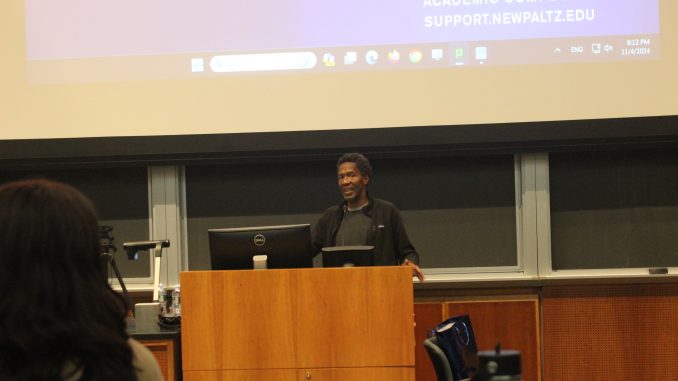
Andre Lambertson was named James H. Ottaway Sr. Visiting Professor for fall of 2024. The Ottaway Visiting Professorship was the first Endowed Professorship in Journalism at SUNY New Paltz, created by James H. Ottaway Sr.
Lambertson is a highly recognized photojournalist with work featured in magazines and galleries including Time Magazine, National Geographic, the New York Times Magazine, The Washington Post, the Smithsonian Museum and the Ford Foundation, among many other notable organizations. He is also experienced in film making, directing and producing documentaries such as the PBS documentary “Charm City,” an Oscar short-listed film that delves into the fraught relationship between Baltimore’s Black community and the police force.
Lambertson gave his SUNY New Paltz audience the privilege of diving into the details of his photojournalistic work during his lecture on Nov. 4 titled “Documenting the Human Experience, From Trauma to Joy.” After introducing himself as someone who is “not a public speaker,” Lambertson expressed hope that his work carries a weight that doesn’t need words. Lambertson’s words were weighty as the images projected on the screen above him. He described his journey as a photographer from housing projects to maximum security U.S. prisons to towns in Liberia with kindness and worldliness.
“Honesty begins behind the camera,” Lambertson said. His focus on photographing Black youth combined with his photographic skill creates a series of intensely emotional and evocative images. He captures the joys and sadnesses of young Black people and adults in a compassionate and powerful way, and opens our hearts with his important work. In a deeply kind and appreciative manner, Lambertson recounted the names and stories of the subjects in almost all of his numerous photos. He expressed during his lecture that it is the responsibility of the artist to get to know their subjects. It is easy to get caught up in the logistics of taking a good photo, getting the right angle and lighting. But the true duty of a photographer is to capture their subject in an honest way and understand their story. Once the subject is understood on a human level, the photographer can do their job. This idea is particularly important in Lambertson’s field of photojournalism but also an idea not often put into practice by others in the field.
Photojournalism is where the importance of telling stories and honestly portraying subjects comes in. Lambertson emphasized honesty as key to the practice of taking portraits. He posed various questions to the audience: how do we tell stories? Who is telling our stories? How are different groups of people portrayed in the media? Do these portrayals honestly represent society, race and class? Lambertson invited participants to rethink how stories are told and how media is consumed through the questions. He fights to make visible stories that would not be seen without his photography. How can we fight for visibility and honest representation? Not just of traumas, but of joys too? Lambertson said during his talk, “Compassion is wildly underrated.” Being compassionate, although seemingly unrelated to photography, became the overarching theme of the night.
The idea of transformation also came into play as a key concept to Lambertson’s lecture. “Are people broken? How do people move through pain? How do people go from powerless to powerful? Is rebirth possible for people who have seen complete darkness for most of their lives?” These questions were posed to guide the audience while still promoting individual thought and reaction.
Lambertson’s lecture and beautiful photo work proved to the audience that rebirth is not just possible, but the only option for survival, even for those who have experienced unimaginable pain. Through photography, Lambertson told the story of men who spent years in max-security prison and left as joyful and better people. A man who found purpose in loving his children and providing for them. A man who went on to find peace in Buddhist teachings. Despite difficult circumstances, people are capable of becoming better versions of themselves, unrecognizable as people they once presented as. This is what Lambertson taught the audience.
Moving into a Q&A with the audience, Lambertson offered key insights. In response to the question “How do you photograph a community that is unfamiliar to you as the photographer in a respectful way?” Lambertson said “make your intentions clear” and “be honest about what you’re doing.” When photographing a community that is unfamiliar to the photographer, it is important to ask questions, practice compassion and make the goal of the images clear to the subject. Honesty, once again, is key to the practice.
At the end of the lecture, Lambertson showed a short film he worked on following the stories of Black mothers who lost their sons to gun violence. Finding joy in unexpected and small places was another takeaway from Lambertson’s lecture. A group of mothers with similarly tragic experiences joined together to discuss their pain. This unimaginably awful experience, which is mostly not talked about, helped the mothers find community. People heal together. Community can be found in suffering. Visibility and honesty opens hearts. Art and photography serve us by opening our minds and hearts, and representation is a stepping stone to building a better future – a future in which powerless people can become powerful and portrayals in the media are honest.
